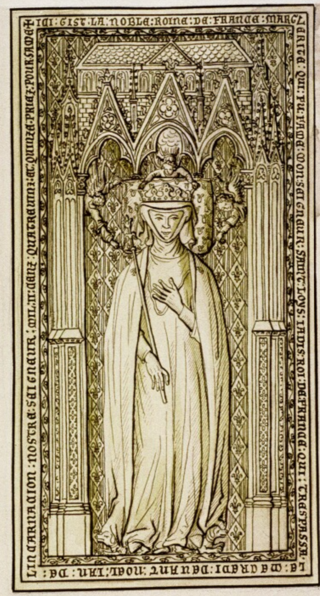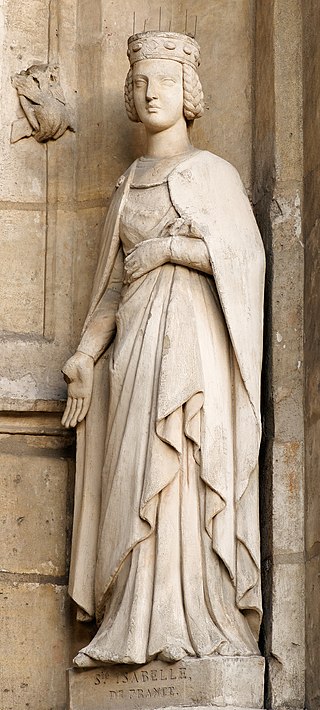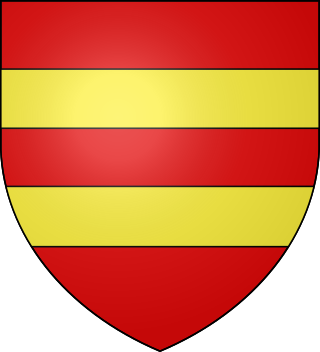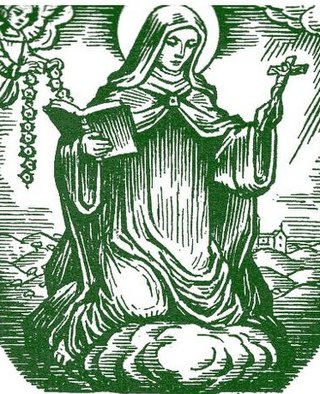Related Research Articles

Shaftesbury Abbey was an abbey that housed nuns in Shaftesbury, Dorset. It was founded in about 888, and dissolved in 1539 during the English Reformation by the order of Thomas Cromwell, minister to King Henry VIII. At the time it was the second-wealthiest nunnery in England, behind only Syon Abbey.

Margaret of Provence was Queen of France by marriage to King Louis IX.

Adela of Champagne, also known as Adelaide, Alix and Adela of Blois, was Queen of France as the third wife of Louis VII. She was regent of France from 1190 to 1191 while her son Philip II participated in the Third Crusade.

Isabelle of France was a French princess and daughter of Louis VIII of France and Blanche of Castile. She was a younger sister of King Louis IX of France and of Alfonso, Count of Poitiers, and an older sister of King Charles I of Sicily. In 1256, she founded the nunnery of Longchamp in part of the Forest of Rouvray, west of Paris. Isabelle consecrated her virginity and her entire life to God alone. She is honored as a saint by the Franciscan Order. Her feast day is 26 February.
Margherita Colonna, was a member of the Colonna family, which was notable in Italian history for centuries. She lived as a nun, with her followers.

Barking Abbey is a former royal monastery located in Barking, in the London Borough of Barking and Dagenham. It has been described as having been "one of the most important nunneries in the country".

Princess Isabelle Françoise Hélène Marie d'Orléans was a member of the House of Orléans and, by marriage, a member of the ducal Harcourt family and of the princely House of Murat.

The House of Harcourt is a Norman family, and named after its seigneurie of Harcourt in Normandy. Its mottos were "Gesta verbis praeveniant", "Gesta verbis praevenient", and "Le bon temps viendra ... de France".
When the Viking chieftain Rollo obtained the territories via the Treaty of Saint-Clair-sur-Epte which would later make up Normandy, he distributed them as estates among his main supporters. Among these lands were the seigneurie of Harcourt, near Brionne, and the county of Pont-Audemer, both of which Rollo granted to Bernard the Dane, ancestor of the lords (seigneurs) of Harcourt. he first to use Harcourt as a name, however, was Anquetil d'Harcourt at the start of the 11th century.

Longchamp Abbey, known also as the Convent of the Humility of the Blessed Virgin, was a convent of Poor Clares founded in 1255 in Auteuil, Paris, by Saint Isabelle of France. The site is now occupied by Longchamp Racecourse.

Chiara Offreduccio, known as Clare of Assisi, is an Italian saint who was one of the first followers of Francis of Assisi.

Henri de Lorraine, known as Cadet la Perle, was a French nobleman. He was count of Harcourt, count of Armagnac, count of Brionne and viscount of Marsan. He was the younger son of Charles I, Duke of Elbeuf and his wife Marguerite de Chabot, countess of Charny.
Richard of Harcourt was Baron of Harcourt, Saint-Sauveur-le-Vicomte and Auvers, Lord of Elbeuf, Bourgtheroulde-Infreville, La Saussaye, Brionne, Beaumont-le-Roger, Angeville, and Saint-Nicolas-du-Bosc, and others.

Anne d'Orléans was a French abbess. She was the youngest child of Charles, Duke of Orléans, and Maria of Cleves. Her only brother became King Louis XII of France in 1498.

Saint Berthild, also known as Bertille or Bertilla, was abbess of Chelles Abbey in France.
Blanche of France, nun at Longchamp Abbey, was the fourth and youngest daughter of King Philip V of France and Countess Joan II of Burgundy.

Pentemont Abbey is a set of 18th and 19th-century buildings at the corner of Rue de Grenelle and Rue de Bellechasse in the 7th arrondissement of Paris. The complex had originally been a Cistercian nunnery. The abbey was founded near Beauvais in 1217 and moved to its current site in Paris in 1672 at the behest of King Louis XIV. A reconstruction of the abbey was initiated in 1745 by the Abbess Marie-Catherine Béthisy de Mézières and work was completed in 1783. In the late 18th century, the abbey was one of the most prestigious educational institutions in Paris for daughters of the elite, including two of Thomas Jefferson's. The abbey also provided rooms for ladies of good standing who were in search of rest, including Joséphine de Beauharnais when the case of her separation from her first husband was heard.

Eleanor of Brittany was the sixteenth abbess of Fontevrault.

The Abbey of the Minoresses of St. Clare without Aldgate was a monastery of Franciscan women living an enclosed life, established in the late 13th century on a site often said to be of five acres, though it may have been as little as half that, at the spot in the parish of St. Botolph, outside the medieval walls of the City of London at Aldgate that later, by a corruption of the term minoresses, became known as The Minories, a placename found also in other English towns including Birmingham, Colchester, Newcastle upon Tyne and Stratford-upon-Avon.
Events from the year 1291 in France.
References
- ↑ Henry Gardiner Adams (1857). A cyclopaedia of female biography: consisting of sketches of all women who have been distinguished by great talents, strength of character, piety, benevolence, or moral virtue of any kind. Groombridge. p. 368 . Retrieved 17 December 2011.
- 1 2 3 4 5 6 Field, Sean L. (2003). The Writings of Agnes of Harcourt: The Life of Isabelle of France and the Letter on Louis IX and Longchamp. Indiana: University of Notre Dame Press.
- 1 2 Field, Sean L. (2007). "Agnes of Harcourt, Felipa of Porcelet, and Marguerite of Oingt: Women Writing about Women at the End of the Thirteenth Century". Church History. 76: 298–329.
- ↑ Allirot, Anne-Helene (Spring 2005). "Isabelle de France, soeur de saint Louis: la vierge savante. Etude de la Vie d'Isabelle de France ecrite par Agnes de Harcourt". Medievales: Langue, Textes, Histoire. 48: 55–98.
- ↑ "Agnes D'Harcourt". Elizabeth A. Sackler Center for Feminist Art: The Dinner Party: Heritage Floor: Agnes D'Harcourt. Brooklyn Museum. 2007. Retrieved 17 December 2011.